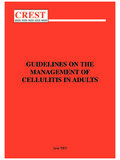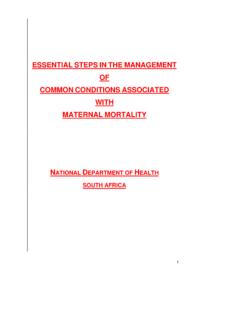Transcription of Recognising Cardiac Disease in Children final - FRCA
1 Recognising Cardiac Disease in Children Name: Elizabeth Storey Hospital: Leeds Teaching Hospitals, UK E-mail: Consider the following 2 cases and discuss the questions below before reading the tutorial. Case A A 3 month old baby presents with poor feeding and failure to thrive. She was born at term after a normal pregnancy. Mum describes that the baby always breathes very fast, that she takes a long time to feed and gets very sweaty. On examination the baby is pink, malnourished and breathless. She has a respiratory rate of 50 and has marked intercostal and sub-costal recession. She has a loud pan-systolic murmur and her liver is palpable at 2cm. A CXR shows increased pulmonary vascular markings and a large heart (>60% of the thoracic diameter). Case B A 9 year old girl presents with fever and chest pain. Her mother informs you that she had a sore throat a few weeks ago for which she did not receive any treatment. On examination you notice that her right knee and left elbow are swollen and painful.
2 On auscultation of her heart you hear a loud pansystolic murmur. Questions: 1. What is meant by cyanotic or acyanotic Cardiac lesions? List example of each. 2. What is Eisenmengers syndrome? 3. What is meant by duct dependence? 4. How can you recognise Cardiac Disease in Children ? 5. What is the likely diagnosis for case A and where does it fit into your classification? 6. List as many different Cardiac lesions as you can think of and describe the type, and location of the murmur associated with it eg aortic stenosis, ejection systolic murmur, upper right sternal edge. 7. Describe how you would systematically look at a paediatric CXR and some of the features you may be looking for in Cardiac Disease . 8. What investigations, if available, could help you to identify Cardiac Disease ? 9. What is the diagnosis for case B and what is the likely cause of the heart murmur? How many Children worldwide do you think are affected with this condition?
3 10. What are the features of an innocent heart murmur? Tutorial: Heart Disease in Children may be congenital or acquired. This tutorial will consider the different types of heart Disease in Children and the recognition and investigation of Children with heart Disease . 1. Congenital heart Disease i. Structural heart defects The incidence of congenital heart Disease (CHD) varies between 5 and 8/1000 live births. The cause of most congenital heart Disease is unknown, but is likely to be related to genetic defects, teratogens (such as maternal alcohol or drugs, including anti-epileptics or warfarin), or maternal Disease (rubella, diabetes). The incidence of different types of structural heart Disease varies between populations, but ventricular septal defect (VSD) is the most common lesion in all populations. The incidence of different types of CHD is shown in table 1 below. Table 1. The incidence of types of CHD in the UK Condition Incidence VSD Ventricular septal defect 32% PDA Patent arterial duct 12% PS Pulmonary stenosis 8% CoA Coarctation of the aorta 6% ASD Atrial septal defect 6% TOF Tetralogy of Fallot 6% AS Aortic stenosis 5% TGA Transposition of the great arteries 5% HLHS Hypoplastic left heart syndrome 3% Hypoplastic right heart syndromes 2% AVSD Atrioventricular septal defects 2% Truncus arteriosus (common arterial trunk) 1% ii.
4 Genetic defects Recognisable chromosomal abnormalities are present in 25% of Children with CHD. The diagnosis of a chromosomal abnormality should lead to active assessment for CHD. The most common chromosomal abnormality is Down s syndrome (trisomy 21) 40% of Children with Down s syndrome have CHD, most commonly atrioventricular septal defect (AVSD) or VSD. Genetic defects associated with Cardiac lesions are shown in table 2 below: Table 2. Genetic defects associated with Cardiac lesions Abnormality Clinical features and associated conditions Typical Cardiac lesion Down s syndrome Trisomy 21 Typical facial appearance, single palmar crease, short stature, learning difficulties, lax joints (including cervical spine AVSD, VSD instability), hypothyroidism, obstructive sleep apnoea, leukaemia, duodenal atresia. DiGeorge syndrome ( Catch 22 ) 22q11 deletion Learning difficulties, cleft palate, hypocalcaemia, absent thymus (frequent respiratory infections), typical facial appearance Aortic arch abnormalities, VSD Marfan s syndrome Abnormally tall stature, long fingers, scoliosis, abnormal shaped chest, high arched palate, retinal detachment, inguinal hernia, spontaneous pneumothorax Aortic root dilatation and dissection Apert syndrome Craniosynostosis (premature fusion of cranial sutures), syndactyly (fused fingers), deafness PS, VSD Charge association Abnormal iris (coloboma), choanal atresia (abnormal nasal passageway), developmental delay, abnormal genitalia, ear deformity Variety, including VSD, AVSD VATER Vertebral abnormalities, anal atresia, tracheo-oesophageal fistula, renal abnormalities VSD, TOF Goldenhar syndrome Hemifacial microsomia (poorly developed maxilla/mandible)
5 , difficult intubation, ear abnormalities, cleft palate VSD, TOF iii. Classification of structural defects It is useful to classify congenital heart Disease according to the pathophysiology of the major heart lesion, in particular, whether the lesion is associated with cyanosis ( blue ) or is acyanotic ( pink ), also whether the lesion is associated with abnormal flow between the Cardiac chambers (abnormal shunt ), obstruction to flow, abnormal connections of the major vessels or abnormal mixing. Table 3. Classification of common congenital heart lesions Common examples Comment Acyanotic lesions - pink Left to right shunt i. Restrictive ii. Non-restrictive Small ASD, VSD, PDA Large VSD, PDA, AVSD Large ( non-restrictive ) defects are associated with severe congestive Cardiac failure in infancy. If unrepaired, may lead to pulmonary hypertension and reversal of shunt (Eisenmenger s syndrome, see later). The age at which this occurs depends on the magnitude of the shunt (occurs in infancy for non-restrictive shunt, may occur in adulthood for small, restrictive shunts) Obstructive Aortic stenosis, coarctation of the aorta, pulmonary stenosis Severity of lesion determines age at presentation neonates with severe obstruction may be critically ill Cyanotic lesions - blue Right to left shunt Tetralogy of Fallot (Right ventricular outflow tract obstruction, right ventricular hypertrophy, VSD with aortic override) May present with severe cyanosis and hypercyanotic spells Transposition of the Great Arteries (TGA) TGA may be associated with ASD, VSD, PDA Long term survival requires intervention in early infancy (arterial switch operation)
6 Common mixing Anomalous pulmonary venous drainage with ASD, common arterial trunk, single ventricle Present with heart failure and cyanosis survival requires intervention in the neonatal period iv. Duct dependent circulation In utero, the placenta is the main site for gas exchange for the developing foetus and the blood flow to the foetal lung is minimal. Blood from the right ventricle bypasses the lungs and passes directly from the pulmonary artery to the aorta via a foetal vessel called the arterial duct. After birth, a number of changes occur in transition from the foetal to the newborn circulation including expansion of the lungs (which reduces pulmonary vascular resistance) and closure of the arterial duct, so that blood now perfuses the lungs. There are certain severe congenital Cardiac lesions that are only compatible with life if the arterial duct remains open the circulation is said to be duct dependent . These babies typically present with acute collapse as the duct closes within the first 5 days of life (the differential diagnosis is septic shock).
7 Examples of duct dependent circulations include critical coarctation of the aorta (duct dependent systemic circulation) or pulmonary atresia (duct dependent pulmonary circulation). In critical coarctation there is extreme narrowing of the aorta just where the arterial duct joins the aorta, and blood supply to the lower half of the body is only possible if it passes from the pulmonary artery to the descending aorta via the duct. In pulmonary atresia, the only blood supply to the lungs is that which passes from the aorta to the pulmonary artery via the duct. Continued survival of these babies requires infusion of prostglandin E1 (prostin) to keep the duct open until urgent Cardiac surgery is possible. NB prostin also causes pyrexia and apnoeas and these babies may require ventilation while on prostin infusions. v. Eisenmenger s syndrome Lesions associated with left to right shunt, such as AVSD, cause high pulmonary blood flow and congestive Cardiac failure.
8 The normal physiological response to high pulmonary blood flow is for the pulmonary vascular resistance to increase. With time, the pulmonary vascular resistance will exceed the systemic vascular resistance, and the flow across the shunt will reverse (Eisenmenger s syndrome). Clinically, this is associated with an initial improvement in symptoms of Cardiac failure as pulmonary blood flow reduces, followed by increasing cyanosis as the shunt reverses to become right to left. Surgical closure of the shunt is not possible at this stage as the resistance to flow through the pulmonary circulation is too high and right ventricular failure will occur. Individuals with Eisenmenger s syndrome are deeply cyanosed, may develop haemoptysis, endocarditis or cerebral abscess, and will eventually die from Cardiac failure. Eisenmenger s syndrome occurs before the age of 1 year in Children with very high pulmonary blood flow, such as unrepaired AVSD, but may occur at the age of 40-50 years in adults with unrepaired ASD who have had moderately increased pulmonary blood flow over many years.
9 Corrective Cardiac surgery to avoid Eisenmenger s must be undertaken before the onset of pulmonary vascular Disease , the ideal age dependent on the severity of the underlying lesion. vi. Further details and diagrams of the normal heart and common congenital heart lesions. See the following web links for further details of congenital heart lesions: vii. Arrhythmias in Children Another form of congenital heart Disease in Children may be the presence of abnormal conduction pathways that lead to the development of Cardiac arrhythmias, particularly supraventricular tachycardia. Supraventricular tachycardia may be caused by abnormal conduction pathways such as the Wolf-Parkinson-White syndrome, characterised on the ECG by a short P-R interval and an abnormal delta wave on the upstroke of the QRS complex. The child may develop sudden episodes of tachycardia associated with heart rates of >240beats/min, up to 300beats/min. These appear on ECG as narrow complex rhythms.
10 The child may feel faint and uncomfortable during an arrhythmia. The arrhythmia may terminate spontaneously or be terminated by vagal manoeuvres such as brief immersion of the face in ice cold water, carotid sinus massage (massage to the carotid artery in the neck), or in older Children , a Valsalva manoeuvre. Specific treatment is with rapid bolus of intravenous adenosine, or if this fails, synchronised cardioversion. Beta blockers may be used to prevent further episodes of tachyarrhythmia many Children will grow out of these episodes with time. Transcatheter radiofrequency ablation of the accessory pathway is undertaken in specialist centres for older Children whose symptoms are not controlled by drugs. Supraventricular tachycardia must be differentiated from ventricular tachycardia (VT). In VT the rate is often slower (<200 beats/min), with wide complexes on the ECG with no association between the QRS complex and the P wave.


















